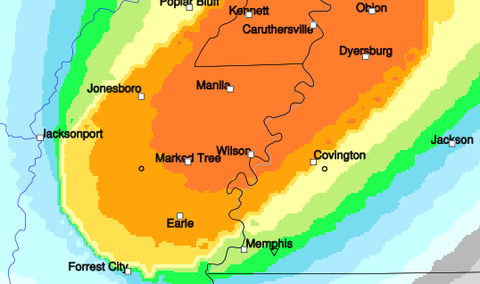Natural Disasters & Selecting Your Generator Fuel Type
We are sometimes asked what precautions to take when selecting a standby generator, given the possibility of an earthquake.
The mid-south area is in close proximity to the New Madrid fault line with an epicenter in northeast Arkansas. There were two earthquakes in December, 1811 and two more followed in early 1812, each with a magnitude of 7.0 or greater. Ground shaking in the Memphis area was ranked IX or, “violent”, on the Modified Mercalli scale. A quake of similar magnitude could cause moderate to severe damage to substantial buildings, with a possible partial collapse. Some buildings may be shifted off foundations. Walls could fall down or collapse.
Below is a USGS mapped probability of an earthquake with magnitude of 5.0 or more within 100 years. Northeast Arkansas, southeast Missouri, and northwest Tennessee have the greatest potential with probabilities approaching 40%.

Memphis will certainly feel a major quake with results varying based upon the magnitude.
So—if you’re considering a standby generator for your home or business, two questions one might have include, “What services might be impacted?” and “What factors should I consider before purchasing a standby generator?”
What services might be impacted?
A minor earthquake will result in rattled nerves but, most likely, minor damage. In a moderate to severe quake, expect widespread power outages and disrupted fuel lines. The fire marshal might order natural gas lines be shut down as a fire preventive measure. Bringing natural gas lines back on line after a moderate to severe quake could take months, perhaps over a year, depending upon the extent of damage to natural gas lines.
Understanding the Different Generator Fuel Types
Most purchasers of a standby generator are focused on the frequency of power outages or in preparation for extended outages due to ice storms, hurricanes, or severe thunderstorms. There are those who are also concerned about the potential of an earthquake with many thinking the odds are increasingly favorable.
Most residential standby generators are fueled with natural gas. The same generator can operate on liquid propane vapor. Switching from natural gas to LP may or may not require additional parts from your generator manufacturer. Consult your dealer for details.
Two generator manufacturers, Cummins and Kohler, offer dual-fuel generators. A dual-fuel generator has two fuel regulators, one for natural gas and the other for LP. Natural gas is considered primary and LP is secondary. If natural gas lines go down, a dual fuel generator will automatically switch to LP.
Don’t confuse the term “dual-fuel generator” with generators that can be fueled from natural or LP. A true dual fuel generator accepts two independent gas lines, one being NG and the other LP.
Some folks don’t like the idea of having a propane tank sitting out in their yard. Smaller 130-gallon propane tanks sit upright and look much like a hot water heater. Larger tanks can be buried to eliminate the unsightly view. Or, consider planting shrubs to hide the tank from street views.
A diesel generator is another option to consider if you are concerned about the potential of a major earthquake event. Diesel generators have a built-in subbase fuel tank and often are seismic-certified. Local diesel fuel service providers offer delivery of diesel fuel to owners. Expect to pay a premium for diesel generators.
If you like the idea of having a true “Dual-Fuel Generator” but you’re not quite ready to install a propane tank, consider ordering a generator with dual-fuel capability. You can always add the second fuel line at a later date.
For more information or questions concerning standby generators, generator sizing or anything related to standby power, feel free to call the generator pros at Buckeye Power Systems. You can reach us Monday - Friday, 9:00 am to 5:00 pm at 901-379-8097.
